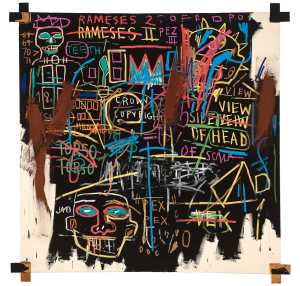'As beautiful as the chance meeting on a dissecting table of a sewing machine and an umbrella.' This quotation from the obscure novel length prose poem 'Les Chants de Maldoror' (1869) was a favourite of the surrealists. Magritte has given an almost literal visual translation: as beautiful as the chance meeting of a lion, a billiards table and many other objects on a country lane.

Specifications
| Title | La jeunesse illustrée |
|---|---|
| Material and technique | Oil on canvas |
| Object type |
Painting
> Painting
> Two-dimensional object
> Art object
|
| Location | This object is in storage |
| Dimensions |
Height 200,7 cm Width 152,9 cm Thickness 5,3 cm |
|---|---|
| Artists |
Artist:
René Magritte
|
| Accession number | 2940 (MK) |
| Credits | Purchased 1977 |
| Department | Modern Art |
| Acquisition date | 1977 |
| Creation date | in 1937 |
| Collector | Collector / Edward James |
| Provenance | Edward James, Chichester 1937-64; Edward James Foundation, Chichester 1964-77 |
| Exhibitions | Worthing/Eastbourne 1963-64; Paris 1972; Rotterdam 1996a; Brussels 1998; Brighton 1998; Porto 2001; London/Rotterdam/Bilbao 2007-08; New York/Houston/Chicago 2013-14; Edinburgh/Hamburg/Rotterdam 2016-17 |
| Internal exhibitions |
Gek van surrealisme (2017) |
| External exhibitions |
Magritte: The Mystery of the Ordinary 1926-1938 (2013) Surreal Encounters - Collecting the Marvellous (2016) Dalí, Ernst, Miró, Magritte... (2016) Dal nulla al sogno (2018) Surrealist Art - Masterpieces from Museum Boijmans Van Beuningen (2021) A Surreal Shock. Masterpieces from Museum Boijmans Van Beuningen (2023) Dalí, Magritte, Man Ray and Surrealism. Highlights from Museum Boijmans Van Beuningen (2023) A Surreal Shock – Masterpieces from Museum Boijmans Van Beuningen (2021) Only the Marvelous is Beautiful (2022) |
| Research |
Show research A dream collection - Surrealism in Museum Boijmans Van Beuningen |
| Literature | Sylvester 1992a, p. 243; Sylvester 1993a, p. 238, cat. no. 429; Rotterdam 2007, pp. 116-17; New York/Houston/Chicago 2013-14, pp. 197-98, fig. 118; Edinburgh 2016, pp. 200, 215, 217, 248, cat. no. 92 |
| Material | |
| Object | |
| Geographical origin | Belgium > Western Europe > Europe |
Entry catalogue A dream collection - Surrealism in Museum Boijmans Van Beuningen
Author: Marijke Peyser
In La jeunesse illustrée René Magritte depicted elements from everyday life: a barrel, a female torso, a lion, a billiard table, a tuba, a birdcage, a bicycle, an armchair, a globe and a ladder are lined up behind one another on a country road. Magritte found inspiration for these motifs in the Larousse dictionaire encyclopédique in the home of the English patron and collector Edward James, with whom he stayed for some time in 1937, and in his own home at 135 rue Esseghem in Jette-Brussels.[1] The work was made as part of the commission for a triptych, which Magritte received from James during his stay in James’s house in London (see Le modèle rouge III). The lion in the painting is a faithful reproduction of an illustration in the ‘Larousse’.[2] The armchair, the globe and the ladder were present in the house in London. The tuba refers to Magritte’s house: a photograph of his junk room in Brussels shows the same brass musical instrument in front of the mantelpiece.[3] The objects are ordinary but the location and the relationship between them are anything but. The contrasts arouse the viewer’s curiosity and at the same time have an unsettling effect.
By depicting everyday objects in a setting where they are not usually to be found, the artist wanted to show a different reality. In February 1937 during his stay with James, Magritte gave a lecture in the London Gallery, in which he gave an explanation of this other reality. He began with the words: ‘The demonstration that we are about to undertake together will aim to illustrate certain features peculiar to words, images and real objects.’[4] One of the examples he used to demonstrate this different reality was ‘the egg in the cage’, which features in a 1932 painting, Les affinités électives. He reasoned that we usually link a bird to a cage, but our interest is aroused if the bird is replaced by a fish or a shoe.
In a lecture given more than a year later, entitled ‘La ligne de vie’ (1938), Magritte discussed the different methods he used to depict the ‘disturbing poetic effect’ he wanted to achieve in his works. He did this by thinking up new objects and transforming existing ones or by making a connection with the subconscious and the external world. Magritte’s objects are part of a visual repertoire that he used in his paintings time after time.
Footnotes
[1] See New York/Houston/Chicago 2013-14, p. 208, note 19: Larousse universel en deux volumes: Nouveau dictionnaire encyclopédique, Claude Augé (ed.). Magritte may also have consulted this reference book for the shoes of Le modèle rouge (1935/1937), see no. 62.
[2] Ibid., p. 198.
[3] See Ceuleers 1999, p. 63.
[4] Sylvester 1993a, p. 53.
All about the artist
René Magritte
Lessen 1898 - Schaarbeek 1967
René Magritte studied at the academy in Brussels. He began as pattern designer in a carpet factory and as painter by painting and designing advertising posters...
Bekijk het volledige profiel






















